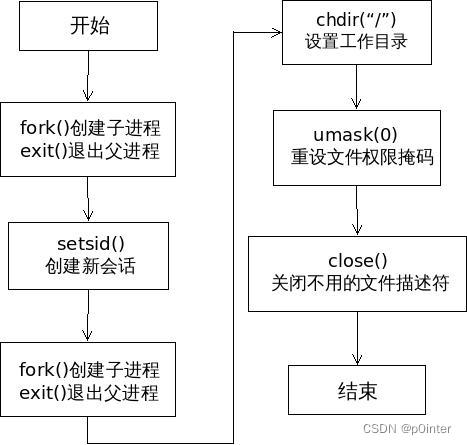1 守护进程的概述
Daemon(守护进程)是运行在后台的一种特殊进程。它独立于控制终端并且周期性地执行某种任务或等待处理某些发生的事件。它不需要用户输入就能运行而且提供某种服务,不是对整个系统就是对某个用户程序提供服务。Linux系统的大多数服务器就是通过守护进程实现的。常见的守护进程包括系统日志进程syslogd、 web服务器httpd、邮件服务器sendmail和数据库服务器mysqld等。
守护进程一般在系统启动时开始运行,除非强行终止,否则直到系统关机都保持运行。守护进程经常以超级用户(root)权限运行,因为它们要使用特殊的端口(1-1024)或访问某些特殊的资源。
守护进程的父进程是init进程,因为它真正的父进程在fork出子进程后就先于子进程exit退出了,所以它是一个由init继承的孤儿进程。守护进程是非交互式程序,没有控制终端,所以任何输出,无论是向标准输出设备stdout还是标准出错设备stderr的输出都需要特殊处理。
守护进程的名称通常以d结尾,比如sshd、xinetd、crond等。
2 守护进程的创建
首先我们要了解一些基本概念:
进程组 :
- 每个进程都属于各自的进程组
- 每个进程都有一个进程组号,该号等于该进程组组长的PID号 .
- 一个进程只能为它自己或子进程设置进程组ID号
会话:
会话(session)是一个或多个进程组的集合。setsid()函数可以建立一个新会话:
如果,调用setsid的进程不是一个进程组的组长,此函数创建一个新的会话。
- 此进程变成该会话的首进程
- 此进程变成一个新进程组的组长进程。
- 此进程没有控制终端,如果在调用setsid前,该进程有控制终端,那么与该终端的联系被解除。 如果该进程是一个进程组的组长,此函数返回错误。
- 为了保证这一点,我们先调用fork()然后exit(),此时只有子进程在运行,子进程不会是进程组的组长
编写守护进程的一般步骤步骤:
-
在父进程中执行fork并exit推出:保证调用setsid()函数的进程不是进程组组长
-
在子进程中调用setsid函数创建新的会话:调用进程成为新的会话组长和新的进程组长,并与原来的会话和进程组脱离。由于会话对控制终端的独占性,进程同时与控制终端脱离。
-
再次 fork() 一个子进程并让父进程退出:现在,进程已经成为无终端的会话组长,但它可以重新申请打开一个控制终端,可以通过 fork() 一个子进程,该子进程不是会话首进程,该进程将不能重新打开控制终端。退出父进程。
-
在子进程中调用chdir函数,让根目录 ”/” 成为子进程的工作目录:使用fork创建的子进程继承了父进程的当前工作目录。由于在进程运行中,当前目录所在的文件系统(如“/mnt/usb”)是不能卸载的,这对以后的使用会造成诸多的麻烦(比如系统由于某种原因要进入单用户模式)。因此,通常的做法是让"/"作为守护进程的当前工作目录,这样就可以避免上述的问题,当然,如有特殊需要,也可以把当前工作目录换成其他的路径,如/tmp。改变工作目录的常见函数是chdir。
-
在子进程中调用umask函数,设置进程的umask为0:进程从创建它的父进程那里继承了文件创建掩模。它可能修改守护进程所创建的文件的存取位。为防止这一点,将文件创建掩模清除:umask(0)
-
在子进程中关闭任何不需要的文件描述符
4、5、6步骤是修改继承来自父类的资源,顺序无所谓。
一张简单的图可以完美诠释之前几个步骤:

以下程序是创建一个守护进程,然后利用这个守护进程每隔一分钟向daemon.log文件中写入当前时间,当守护进程收到 SIGQUIT 信号后退出。
#include <unistd.h>
#include <signal.h>
#include <stdlib.h>
#include <string.h>
#include <fcntl.h>
#include <sys/stat.h>
#include <time.h>
#include <stdio.h>static bool flag = true;
void create_daemon();
void handler(int);int main()
{time_t t;int fd;create_daemon();struct sigaction act;act.sa_handler = handler;sigemptyset(&act.sa_mask);act.sa_flags = 0;if(sigaction(SIGQUIT, &act, NULL)){printf("sigaction error.\n");exit(0);}while(flag){fd = open("/home/mick/daemon.log", O_WRONLY | O_CREAT | O_APPEND, 0644);if(fd == -1){printf("open error\n");}t = time(0);char *buf = asctime(localtime(&t));write(fd, buf, strlen(buf));close(fd);sleep(60);}return 0;
}
void handler(int sig)
{printf("I got a signal %d\nI'm quitting.\n", sig);flag = false;
}
void create_daemon()
{pid_t pid;pid = fork();if(pid == -1){printf("fork error\n");exit(1);}else if(pid){exit(0);}if(-1 == setsid()){printf("setsid error\n");exit(1);}pid = fork();if(pid == -1){printf("fork error\n");exit(1);}else if(pid){exit(0);}chdir("/");int i;for(i = 0; i < 3; ++i){close(i);}umask(0);return;
}
注意守护进程一般需要在 root 权限下运行。
通过
ps -ef | grep 'daemon'
可以看到:
root 26454 2025 0 14:20 ? 00:00:00 ./daemon
并且产生了 daemon.log,里面是这样的时间标签
Thu Dec 8 14:35:11 2016
Thu Dec 8 14:36:11 2016
Thu Dec 8 14:37:11 2016
最后我们想退出守护进程,只需给守护进程发送 SIGQUIT 信号即可
sudo kill -3 26454
再次使用 ps 会发现进程已经退出。
3 利用库函数daemon()创建守护进程
其实我们完全可以利用 daemon() 函数创建守护进程,其函数原型:
#include <unistd.h>int daemon(int nochdir, int noclose);DESCRIPTION The daemon() function is for programs wishing to detach themselvesfrom the controlling terminal and run in the background as systemdaemons.If nochdir is zero, daemon() changes the process's current workingdirectory to the root directory ("/"); otherwise, the current workingdirectory is left unchanged.If noclose is zero, daemon() redirects standard input, standardoutput and standard error to /dev/null; otherwise, no changes aremade to these file descriptors.RETURN VALUE (This function forks, and if the fork(2) succeeds, the parent calls_exit(2), so that further errors are seen by the child only.) Onsuccess daemon() returns zero. If an error occurs, daemon() returns-1 and sets errno to any of the errors specified for the fork(2) andsetsid(2).
daemon() 函数将调用进程变成守护进程。
参数:
nochdir:=0将当前目录更改至“/”
noclose:=0将标准输入、标准输出、标准错误重定向至“/dev/null”
#include <stdio.h>
#include <unistd.h>
#include <stdlib.h>
#include <time.h>
#include <fcntl.h>
#include <string.h>
#include <sys/stat.h>#define ERR_EXIT(m) \
do\
{\perror(m);\exit(EXIT_FAILURE);\
}\
while (0);\
void creat_daemon(void);
int main(void)
{time_t t;int fd;if(daemon(0,0) == -1)ERR_EXIT("daemon error");while(1){fd = open("daemon.log",O_WRONLY|O_CREAT|O_APPEND,0644);if(fd == -1)ERR_EXIT("open error");t = time(0);char *buf = asctime(localtime(&t));write(fd,buf,strlen(buf));close(fd);sleep(60); }return 0;
}
运行结果和上面一样




收集)
、cin.getline()、getline()、gets()等函数的用法)
方法与示例)


方法与示例)

)

方法与示例)


)
方法与示例)

